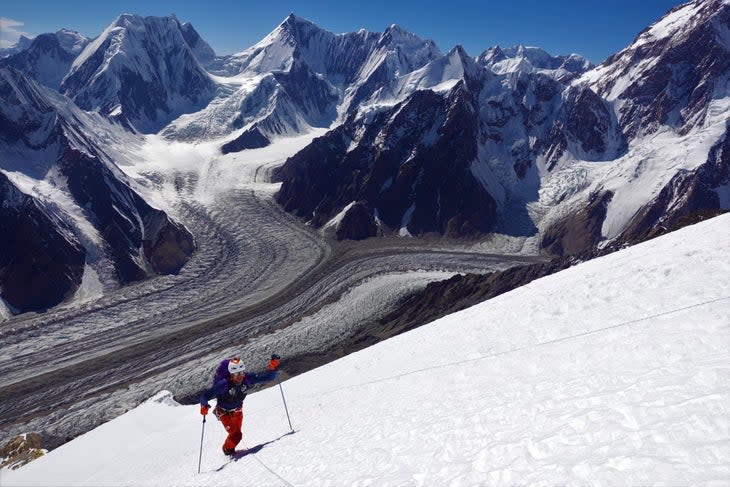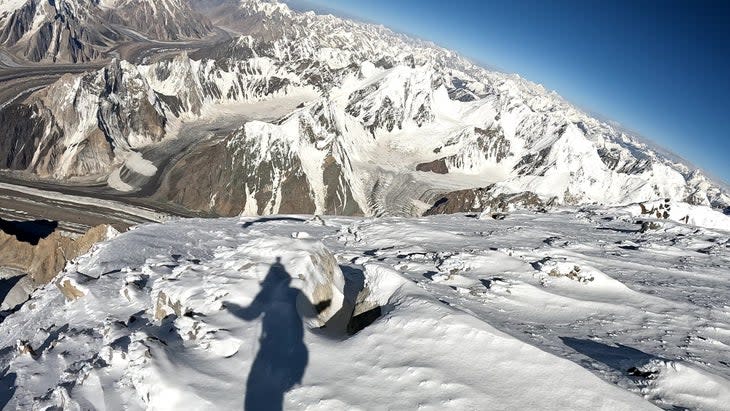Benjamin Védrines on Himalayan Speed Records, Para-alpinism, and Passing Out on K2
This article originally appeared on Climbing
Benjamin Vedrines, of Monnetier, France, is relatively new to the 8,000-meter climbing scene, but has an impressive resume spanning all mountain genres: hard mixed, committing ski descents, protracted trail runs, and exploratory paragliding. Vedrines stumbled onto many peoples' radar last October when he opened the North Face of Chamlang (7,319 meters) with Charles Dubouloz: the sustained In the Shadow of Lies (ED WI 5+ M5+ 90deg; 1,600m).
This summer, Vedrines returned to the Himalaya with the goal of climbing Broad Peak (8,051 meters) as his first 8000er. He'd been cardio focussed all spring, including a 28-hour ski traverse of the Ecrins massif with some 32,000 feet of ascent, and arrived at Broad Peak's base camp feeling fit and eager to climb quickly at altitude.
Vedrines warmed up on the West Ridge (the peak's "normal route," replete with Sherpa-installed fixed lines and boot packs) and climbed to the summit in a day on July 9. He returned to camp feeling surprisingly strong, despite climbing without supplementary oxygen, and ten days later he returned to the West Ridge for a speed attempt. Vedrines climbed from the 4,900-meter camp to the summit in a blistering seven hours and 28 minutes. He launched his paraglider from the top in "perfect" conditions, landing back at base camp after one hour of flight--just in time for breakfast.
Vedrines was certainly pleased with his performance on Broad Peak but he was far from satisfied. As he told me in the interview below, which has been edited for clarity and length, this drive for greater performance nearly led to his death on K2--a far higher and more technically challenging objective.

The Interview
Climbing: Broad Peak was your first 8000er. Then you went to K2. How did you prepare for this expedition, and did you originally plan to climb two 8000ers and descend via paraglider?
Vedrines: I prepared for the K2 expedition mainly during the spring, focusing my training time on endurance. During the winter I climbed 8a [5.13b] and did a very nice trilogy of three major north faces in the Alps with Leo Billon and Seb Ratel. After that, I stopped climbing and devoted myself to skiing, cycling, walking, and flying. I did two great ski-mountaineering crossings: the Ecrins massif, in 28 hours with 10,000 meters of ascent, and the Mont Blanc massif in 20 hours with 7,500 meters of ascent. These two experiences allowed me to gain a lot of confidence before the expedition.
Broad Peak was the main goal for this expedition, but I had not planned to descend it by paragliding. Once I was there I realized that it was possible to take off from the summit. Thanks to Nicolas Jean, who went up there before me, and who was able to describe the profile of the summit slope. It was only with his help that mixing the two challenges was then imaginable!
Climbing: Did you encounter any difficult moments on the climb, particularly on the tricky, technical summit ridge? And how was your descent with the paraglider?
Vedrines: I never felt too much difficulty during the climb. I think I was very well prepared. However, by forcing myself to move so quickly, I had to remain concentrated in my physical effort and to maintain the pace. At around 7,600 meters my heart was beating very hard and I was afraid of forcing too much and of having problems related to the altitude. This is mainly what I remember: this anxiety linked to the altitude.
The summit ridge was not very difficult for me, especially since the track was very good that day. It was much tougher nine days earlier when I first summited. For the paragliding flight, the takeoff was very pleasant and there was the perfect wind to take off serenely. Then I was able to fly over the North Ridge, above the climbers, passing a little on the Chinese side. Then I was able to enjoy 25 minutes of flight, admiring the surrounding peaks, and finally land near the base camp, on ice.

Climbing: What gear did you carry with you during the climb?
Vedrines: I had two different bags: a 22-liter bag in a very light fabric (about 80 grams) and a 120-gram trail-running vest. At the start [4,890 meters to 7,600 meters] I had a first-aid kit of about 80-100 grams, 1.5 liters of water, and about 200 grams of food in my vest. From 7,600 to the summit, I added in the small bag carrying a paraglider (1,410 grams). For the fixed ropes, my goal was not to climb without them. In this environment [on the West Ridge], climbing right next to a fixed rope is not considered alpine style, so I used them from time to time, about 5% of the route, with my hands. I didn’t have a jumar.
Climbing: On your next objective, a fast ascent of K2, you fell ill after reaching 8,000 meters. I read that you lost consciousness and you were given supplemental oxygen by passing climbers. Can you tell me how you felt in the moments before you lost consciousness?
Vedrines: To be completely honest, I didn’t feel anything tangible that could have led me to understand that I was going to be in a very dangerous situation. The first moments above 8,000 meters went well. I felt tired, but that was normal at my pace and at that altitude. At 8,300 meters my condition suddenly deteriorated. Instantly, I no longer had the same energy, nor the same state of consciousness. It’s from there that I don’t remember everything.
Climbing: Now that you're safely back home, how do you feel about your decision making on K2? It is possible that you forced yourself too much?
Vedrines: It’s true that it was a big risk to try K2 after having climbed Broad Peak twice without oxygen, once at a very fast pace. When I decided to go to K2, I didn’t want to set an ascent record. I didn’t want to climb at the same speed as on Broad Peak. I was mature enough to know it was too risky. My goal was to climb K2 in a day at an appropriate pace.
But, on the day of the ascent, the weather conditions as well as the snow conditions were not good. It really slowed me down and tired me. This accumulation of fatigue weighed on me at Camp 3 and I had to ask myself if I should continue or not. It was at this point that I made a mistake. I decided to continue despite the fatigue, too attracted by this summit. I really thought that if I took it easy I could do it. But you have to understand that the effects of altitude are unpredictable without oxygen.
Looking back, I realize I did not commit to K2 in the best conditions. Those 600 meters more than Broad Peak make a difference. And climbing an 8000er in a day without oxygen is very demanding on the body. Mine did not resist hypoxia. If I had to go back, I would devote all my time to this climb, I would not do demanding climbs before.
Climbing: How do you feel following this expedition, after such a successful double-ascent of Broad Peak to a low point on K2?
Vedrines: It was a very interesting and varied expedition. The first Broad Peak climb gave me confidence, it was my first 8000er. The second Broad Peak climb was one of my best moments as a sportsman: an accomplishment that is rare in the life of a mountaineer. It made me want to go even harder, even higher. And K2 was right there. I went. I could have died up there. I lived the dream on Broad Peak and the nightmare on K2. It allowed me to see my limits. But also the limits of high altitude without oxygen. It’s a very dangerous place, especially for people like me who want to go fast.
After Vedrines' ascent of Broad Peak, some doubted the record-breaking time he claimed. Climbing reviewed Vedrines' GPS-track data and can confirm his 7:28 time--Ed.
Also read:
For exclusive access to all of our fitness, gear, adventure, and travel stories, plus discounts on trips, events, and gear, sign up for Outside+ today.


